First Flight:
Pawel Kwiecinski
![]()
First Flight:
|
|
by Alfred Scott
This article appeared in the December 1987 issue of the Falco Builders Letter. |
Another Falco completion record has fallen. Pawel Kwiecinski's Falco flew for the first time on October 9, thus becoming the 15th Falco to fly. When Pawel began construction on September 18, 1986, his intention was to build the Falco in six months, primarily because he had to rent a shop and didn't want the rent to add up.
Pawel Kwiecinski moved to the United States from Poland about seven years ago. Pawel is a doctor and his partner's father, Adam Slodowy, was in the U.S. for about six months. Although Adam had never built an airplane before, he was a master craftsman, the author of several 'how-to' books and television personality-for 15 years Adam had a show on Polish television called "Do It Yourself." Could he build a Falco? Sure.
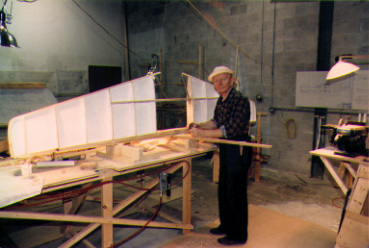
Adam Slodowy
The race was on. Pawel rented a shop and bought some lumber, a radial arm saw and an air compressor. Adam began building tables, racks for materials, and a plan table. Since Adam spoke no English, Pawel sat down and translated the entire construction manual dictating to a cassette recorder. Adam found the plans easy to read since the plans conventions are the same in all countries.
Adam built the tail group in three weeks at a time when they were still setting up the shop. The ailerons and flaps took 17 days, and then Adam began on the wing. The wing was finished and the fuselage started by the beginning of February, and Adam went back to Poland.
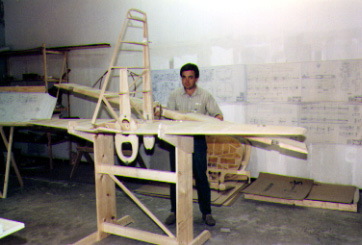
Pawel Kwiecinski
Adam had been working on the plane 10 to 12 hours a day, and Pawel put in a couple of hours each night. A couple of weeks before Adam left, Irek Mikolajczyk (EE-rik Me-ko-LAH-chik) started working on the Falco, and he kept up Adam's full-time schedule. Irek had recently moved to the U.S., and Pawel met him shortly after his arrival.
Irek continued to work on the plane with Pawel. The canopy took two weeks, and Pawel broke out a bottle of champagne to celebrate the occasion. Pawel used the "high Nustrini" canopy, and this caused most of the problems-extending the canopy skirt and fitting the windshield. By the middle of June, the woodwork was essentially complete and the painting began.
The painting took much more time than expected, in all eight weeks from start to finish. The painter who did all the spraying worked part time since he had another job painting boats. He only worked a couple of hours each day and then on Sunday. Irek continued on his full-time schedule, sanding and working on other details. Pawel continued to work evenings. A fourth man put in about 3 hours a day sanding primer. He wanted to lose some weight and by the time the plane was painted, he had lost 25 pounds.
Throughout the construction, the emphasis was on building a beautiful Falco, not just a quick one. So even though the construction went quickly in calendar months, they spent all the time they needed to do each step right. In all, Pawel thinks they spent about 500 hours sanding the paint. He was striving for as smooth a finish as possible, but he came to the conclusion that we have to accept the Falco for what it is-a wooden airplane. You will always see some flaws.
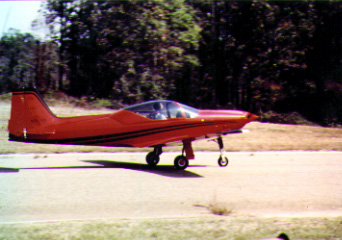
They worked overtime to fly the plane by Oshkosh, and by the time of the show, the Falco was painted in the final topcoat of Porsche red. Karl Hansen had matched the color of his son's Alfa Romeo, and Pawel wanted to match the color of his Porsche 928S. The painter was used to Allgrip, but they did not make the color. Unhappy with that answer, Pawel called up the president of the company and said he wanted some Allgrip to match his Porsche. It turned out the president had a Porsche as well and already had a private stock of the proper red paint. Pawel was in business.
With Oshkosh over, there was no self-imposed deadline, and the project began to slow down a little. Little, last-minute things began to hold up the construction. Moving the airplane to the Waukegan airport was a major event. The airport was 35 miles away, and the shop did not have a large door. Pawel had to get a contractor to knock the concrete-block wall down, put the Falco on a trailer and get it to the airport. There were many false starts. There were building permits required. Pawel had a busy schedule. They needed good weather to move the Falco, and they didn't want to tear the wall down until the plane was ready to be moved.
They were delayed at least a month on the move. Each week Pawel would call to tell me that they were going to move the Falco on Saturday, but then the weather was bad, or the contractor didn't show, or something else. At long last they got it to the airport and assembled the plane. The mechanics at the local airport hooked up the engine. Unforeseen little problems kept delaying things. Pawel would schedule the FAA inspection, then he would find that they needed a couple of hose fittings for the fuel flow transducer, so the inspection was cancelled. Next time it was the sump fitting for the inverted oil system.
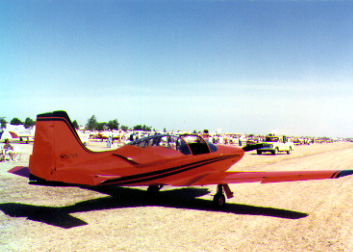
Somewhere along the way, Pawel spent so much time with the Falco that he shirked his domestic responsibilities. It cost him a marriage, but not in the usual homebuilt airplane tradition of "5 years, $20,000 and a divorce." The lady simply said, "Marry me or go live with your Falco!"
For the past several years Pawel has owned a fixed gear Piper Dakota. He put about 200 hours a year on the plane, but he had no experience flying highly maneuverable airplanes with a control stick. Pawel was "of course" planning to do the first flight in the Falco, but after reading of our sternly worded Flight Test Guide he dropped the notion at once. Test flight duties were turned over to the highly qualified Irek Mikolajczyk.
Irek comes from a famous aviation family. His father was a pilot as were all of Irek's brothers. Irek's older brother has been the perennial acrobatic champion of Poland, and Irek usually came in second or third.
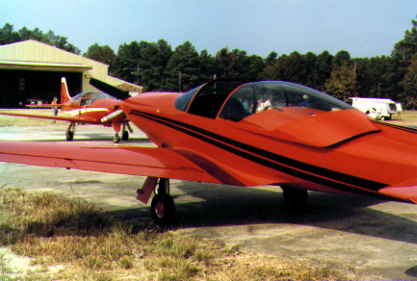
They followed the Flight Test Guide to the letter and had a very successful experience. Ground engine run, taxi tests and controllability tests were all done by the time the FAA inspector arrived. She was amazed at the workmanship, saying that she had not seen anything even close to this in her seven-year career with the FAA in Chicago. She said the finish was as good as the best glass jobs and better than any wood airplane she had seen.
Irek flew the Falco on October 9 for the first time. He found the plane very similar to the Zlins he had flown before and had no trouble with the plane at all. This is the payoff of a careful ground check-Pawel, Irek and the mechanics each took turns with our 20-page final check list.
On the first day, they flew the Falco stiff legged for 2-1/2 hours in all. Irek did stalls and slow flight, and before the day was over he took Pawel for a ride. I always write down the builder's comments after a first flight. Pawel described the plane in short sentences, "It's great! It's fantastic! It's a wonderful plane! It's a nice toy! It's a great thing!"
He also said, "I want to thank you for talking me out of doing the first flight." The Falco was not at all like his Piper Dakota. Pawel didn't remember the exact empty weight, but he recalled that it was something like 1170-1185 lbs without radios.
Irek and Pawel worked hard to fly off the required hours, and a week later they flew the Falco to the SF.260 fly-in at Farmerville. They had a single comm radio, a hand-held nav/com and a nice river to follow.
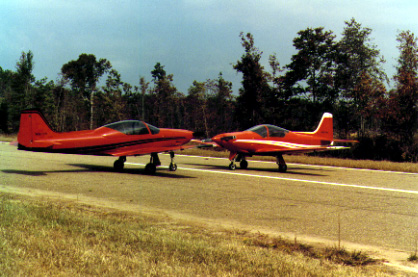
Farmerville faceoff, Pawel's Falco squares off with Karl Hansen's.
The finish on the Falco is indeed exceptional. I was very impressed with how smooth the plywood-skinned ailerons and flaps were. I had been worried that the flat areas on the top might not turn out well, but they were beautiful.
N9171Y is painted with the same scheme as Karl Hansen's, but with the darker Porsche red and with black stripes. The black stripes are very distinctive and do not blend in with the red as I had feared. The higher canopy is not particularly noticable. No one commented on it without prompting.
The seats and side panels are covered with padded black leather. The rest is covered with black leather cemented directly to the plywood. This is a practical solution, but I noticed that there was a substantial difference in the appearance. The padded leather looked smooth and comfortable, and the rest looked hard and rough. The leather picked up imperfections in the finish, and the shiny black surface emphasized them. In retrospect, the interior would have been better if padding was used under all of the leather.
I flew in the Falco with Irek and found that there was plenty of headroom for me. I'm six two and can't ride under a standard Nustrini without bowing my head. In the air, it's the same Falco we all know, except that we timed the rate of roll at 4 seconds to the left. That's a second slower than my old Falco. The seven-second gear retraction time is a joy. That's almost three times faster than the Corporate Disgrace, which is supposed to get it up in 13 seconds but never does.
Irek put on an airshow at altitude with the Falco. He has a small problem at the top of a hammerhead, a trail of oil follows the plane down from the top. The cure for this is thought to be re-routing one of the hoses to eliminate a dip in the line and to use six quarts of oil instead of topping it off at eight.
Pawel did not keep any accurate records of the time spent to built the plane, but he talks about 4,000 hours including painting. He said the construction went smoothly but there was a definite increase in "think time" once they passed the construction manual. The canopy was the worst part, and Pawel underestimated the time for painting and last-minute things. With their experience, Irek says they could build two Falcos side-by-side in eight months without painting. Get your own painter. Pawel's painter says the Falco was his first and last airplane. He is sticking with boats.
All of the radios are installed now, and Pawel is working on gear doors and other little things. Irek now has a regular job and is giving Pawel aerobatic instruction on weekends. They plan to put the Falco into airshows, but Irek feels he needs about 5 months of practice before he does low-level airshow aerobatics.